As I have ridden through the center of Mexico over the past few weeks, I have stayed in many small villages. In these villages, almost every household has a plot of land that they use to grow corn or beans, and most families make their own tortillas. The mother of a family in Minita de Cedro remarked ‘no one buys tortillas here!’ as she showed me how she made tortillas. If there is extra corn, it is fed to the chickens (‘everyone has chickens here’ ‘do you own chickens?’), which are then also eaten or used for eggs.
What does a changing climate mean for these farmers? The results from over a decade of crop modeling and estimates seem to agree: while the food production of the world as a whole may not change much, massive shifts in agriculture will result and the production of poorer, developing countries, which already have a warmer climate, will decline. In other words, climate change will have little or an even beneficial effect on the farms of the northern U.S. and Canada, but it will hurt these small farms in Mexico.
Warmer temperatures in already warm regions generally decrease yields. A friend of mine at Stanford studied wheat production in northern Mexico, and he found that warmer years resulted in lower yields. And this appears to be the story of climate change and agriculture in the tropics — many places in the tropics are near their limit of heat tolerance, and a warmer climate will hurt crops. For instance, India recently experienced warmer than normal temperatures and also lower yields.
On the flip side, plants use carbon dioxide to grow, and more carbon dioxide in the atmosphere may help some crops. This effect, however, is most likely to be strongest in northern latitudes, and not here, in Mexico. Also, most of the estimates of this CO2 effect (see graphs here ) are based on greenhouse experiments, and a number of field studies (such as the one I worked on at Jasper Ridge at Stanford ) suggest that the effects of higher CO2 on plants are less than expected. Also, the CO2 effect is going to be far less for corn than for other crops, and corn is the most important crop — both culturally and economically — here in Mexico.
Global warming will likely result in big shifts in agriculture. For instance, the corn in the U.S. Midwest may be replaced by wheat, and Napa Valley may no longer be suitable for wine grapes. Switching from one crop type to another will take investment, and perhaps even genetic engineering to adapt crops to new climates. Rich northern countries will be able to make these investments, while developing nations will likely struggle.
As I look at the agriculture on these hillsides in Mexico, where most of the knowledge is passed on from one generation to the next, I wonder how easy it will be to change the way these people grow their crops, or even the types of crops they grow. In Presa de Bravo, where I watched these two woman make tortillas (movie left — same movie as before), I asked how they had purchased the land to grow their corn. I was told it was owned by their ancestors, and passed down through the family.
Finally, climate change may make weather more variable — meaning both more good years and more bad years, and fewer average years. If you are a subsistence farmer, you care just as much about consistent yields as you do about the average yield. In every town I stop in, I ask what they do if there is a bad year for corn. Francisco in La Mojada, who is going to sell that wheelbarrow full of corn stalks for $2 for animal feed (photo left), gave me the same answer that everyone else has given me. They have to buy food, and it is very hard. Many of the people move elsewhere when they can’t find work, and a huge percentage of the illegal immigrants in the U.S. are people from these small Mexican villages who were unable to make ends meet. (I asked in one small town how many people in the town were in the U.S., and I was told 10%.)
Right now, there are 800 million people who do not get enough food every day (only a small number of these are in Mexico – most are in Africa or Asia). This a huge problem, and probably deserves its own continent-crossing-awareness-raising bike ride. Helping these people eat enough, though, is often a task of improving agricultural output in these poorer regions. Climate change will only make this more difficult.






hey Dave – thanks again for providing a window into the lives of those you are meeting!
On the extremely important topic of malnutrition and its inextricable link to water, sanitation, hygiene, and education, check out today’s SF chronicle:
“Scant food isn’t cause of child malnutrition. Study says mothers lack knowledge of baby, toddler care.”
http://www.sfgate.com/cgi-bin/article.cgi?f=/c/a/2006/03/03/MNG06HHNHP1.DTL&type=health
Just yesterday a nutrition specialist from the World Bank published a report:
“Malnutrition is among the most serious health problems in the world today that has not been tackled, “says Meera Shekar, the report’s lead author. “Roughly 30% of children in the world are undernourished and in fact 60% of children for example who die of common diseases like malaria and diarrhea would not have died had not they not been malnourished in the first placeâ€
http://worldbank.org/ (click on ‘repositioning nutrition central to development’ for the press release and to access the report)
For those who are interested in reading more about malnutrition, check out some info on the UNICEF website.
http://www.childinfo.org/areas/malnutrition/